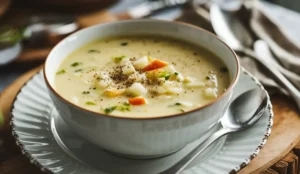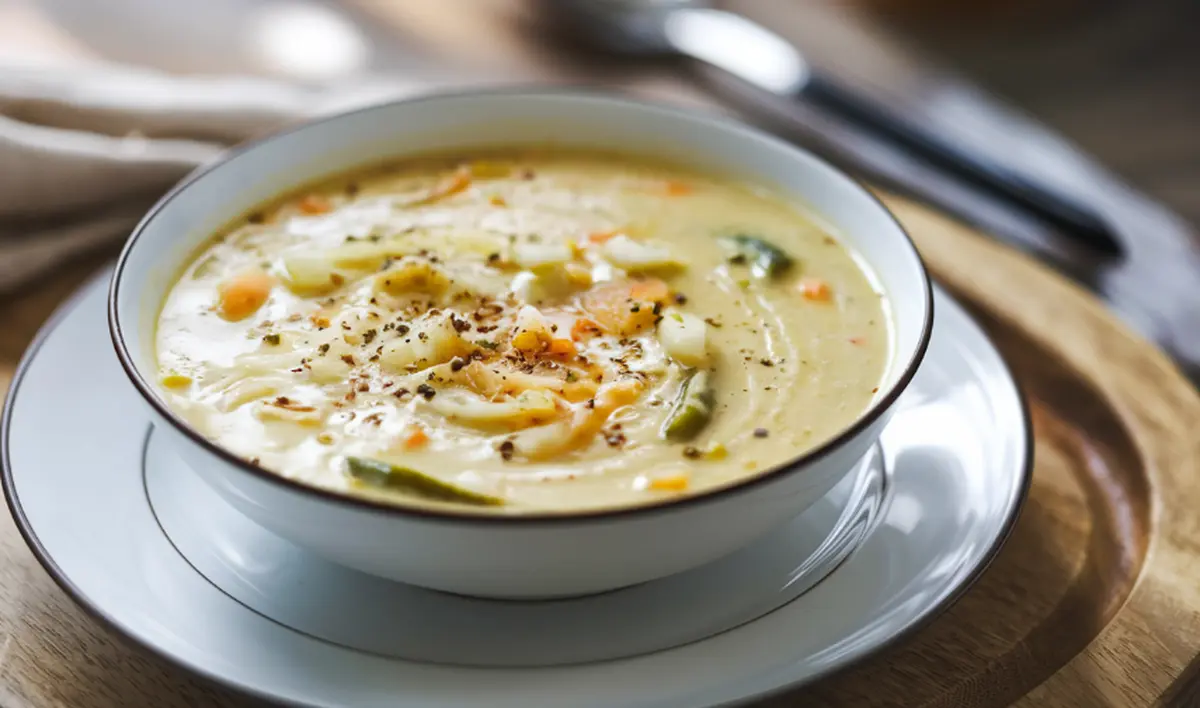Introduction
GERD, or gastroesophageal reflux disease, is a chronic digestive disorder where stomach acid frequently flows back into the esophagus, leading to symptoms such as heartburn, chest pain, and regurgitation. Managing GERD often involves dietary modifications to avoid triggering symptoms. One comforting food that can still be enjoyed with GERD is soup, provided it is made with careful attention to ingredients that won’t exacerbate the condition.
In this blog, we’ll explore the types of soups that are safe for GERD, the ingredients to avoid, and how to prepare delicious and comforting soups that are gentle on your digestive system.
Understanding GERD and the Role of Diet
Before diving into the best soups for GERD, it’s important to understand how diet affects GERD. Certain foods and beverages can relax the lower esophageal sphincter (LES) or increase stomach acidity, both of which can trigger reflux symptoms. Some common culprits include spicy foods, acidic fruits, caffeine, alcohol, and fatty foods. However, by choosing ingredients that are less likely to aggravate GERD, you can still enjoy a variety of soups.
Soups can be an excellent option for GERD sufferers because they are easy to digest, soothing, and can be packed with nutritious ingredients. However, the key to making GERD-friendly soup is to focus on low-acid, low-fat, and non-spicy ingredients. This approach helps minimize the risk of irritating the esophagus and causing heartburn.
Ingredients to Avoid in Soups for GERD
When making or choosing soups, it’s crucial to be mindful of ingredients that can worsen GERD symptoms. Below is a list of common ingredients to avoid:
1. Tomatoes and Tomato-Based Products
Tomatoes are highly acidic and can significantly irritate the esophagus, making them a primary ingredient to avoid. Tomato-based soups like minestrone or tomato bisque should be substituted with alternatives.
2. Spices and Seasonings
Spicy foods, including soups flavored with chili peppers, black pepper, or strong spices, can relax the LES and trigger heartburn. Stick to mild herbs like basil, parsley, or thyme instead.
3. High-Fat Ingredients
Fatty foods slow down digestion and increase stomach acid production. Avoid heavy cream, butter, and high-fat meats such as pork or fatty cuts of beef. Opt for leaner alternatives like chicken breast or turkey.
4. Onions and Garlic
While they add great flavor to soups, both onions and garlic are known to trigger heartburn. You may want to avoid these ingredients or use them sparingly in your soup preparations.
5. Citrus Fruits
Citrus fruits like lemons, oranges, and limes are acidic and can cause reflux. Avoid adding citrus juices or zest to your soup recipes.
6. Alcohol and Caffeine
While alcohol and caffeine are not common soup ingredients, it’s important to note that they can relax the LES and should be avoided by those with GERD. Opt for herbal teas or water as beverages to accompany your meal instead.
GERD-Friendly Soup Ingredients

Now that we’ve covered what to avoid, let’s focus on what you can include in soups that are suitable for GERD. The following ingredients are gentle on the stomach and esophagus while still providing plenty of flavor and nutrients:
1. Bone Broth or Low-Sodium Vegetable Broth
Bone broth and vegetable broth provide a nutritious and soothing base for soups. They are mild, non-acidic, and rich in collagen, which can help repair and soothe the digestive tract. Choose low-sodium versions to further reduce the risk of GERD symptoms.
2. Lean Proteins
Incorporate lean proteins like skinless chicken breast, turkey, or fish into your soups. These proteins are easy to digest and provide necessary nutrients without adding excess fat.
3. Root Vegetables
Carrots, sweet potatoes, and parsnips are naturally sweet, non-acidic, and easy on the digestive system. They add texture, flavor, and color to soups without triggering reflux.
4. Leafy Greens
Leafy greens like spinach, kale, and chard are alkaline and can help neutralize stomach acid. They’re also packed with vitamins and minerals, making them a great addition to your soups.
5. Whole Grains
Adding whole grains like quinoa, barley, or brown rice to soups can increase fiber content and promote healthy digestion. These grains are less likely to cause reflux than refined grains.
6. Herbs and Mild Seasonings
While strong spices can be problematic, mild herbs like parsley, thyme, and oregano can enhance the flavor of your soups without causing irritation. Avoid hot peppers and opt for milder flavor enhancers.
Top 5 GERD-Friendly Soup Recipes
1. Chicken and Vegetable Soup
This classic soup is gentle on the stomach and provides a balanced meal of lean protein and vegetables. To make it GERD-friendly, use skinless chicken breast, carrots, zucchini, spinach, and a low-sodium chicken broth.
Ingredients:
- 2 skinless chicken breasts, diced
- 4 carrots, chopped
- 2 zucchinis, chopped
- 1 cup spinach
- 4 cups low-sodium chicken broth
- 1 teaspoon thyme
- 1 teaspoon parsley
- Salt and pepper to taste (use sparingly)
Instructions:
- In a large pot, bring the chicken broth to a boil. Add the diced chicken and cook for 10-15 minutes until fully cooked.
- Add the chopped carrots and zucchini, and simmer for another 10 minutes.
- Stir in the spinach, thyme, parsley, salt, and pepper. Simmer for 5 minutes.
- Serve warm, enjoying a soothing and filling soup that’s easy on the digestive system.
2. Butternut Squash Soup
Butternut squash is slightly sweet, low in acidity, and rich in vitamins. This soup is creamy without the use of dairy, making it an excellent choice for those with GERD.
Ingredients:
- 1 butternut squash, peeled and cubed
- 1 onion (optional, use sparingly)
- 4 cups low-sodium vegetable broth
- 1 teaspoon nutmeg
- 1 teaspoon thyme
- 1 tablespoon olive oil
- Salt and pepper to taste
Instructions:
- In a large pot, heat olive oil and sauté the onion until soft (omit if sensitive).
- Add the cubed butternut squash and vegetable broth. Bring to a boil, then reduce heat and simmer until the squash is tender, about 20 minutes.
- Using an immersion blender, puree the soup until smooth.
- Stir in nutmeg, thyme, salt, and pepper. Serve warm for a creamy, comforting meal.
3. Ginger Carrot Soup
Ginger is known for its anti-inflammatory properties, making it a good option for soothing the digestive tract. Combined with the natural sweetness of carrots, this soup is both delicious and gentle on the stomach.
Ingredients:
- 6 large carrots, chopped
- 1 tablespoon fresh ginger, minced
- 4 cups low-sodium vegetable broth
- 1 teaspoon turmeric
- 1 tablespoon olive oil
- Salt and pepper to taste
Instructions:
- In a large pot, heat olive oil and sauté the ginger until fragrant.
- Add the chopped carrots and vegetable broth. Bring to a boil, then reduce heat and simmer until the carrots are tender, about 20 minutes.
- Puree the soup with an immersion blender until smooth.
- Stir in turmeric, salt, and pepper. Serve warm and enjoy the soothing, anti-inflammatory benefits.
4. Sweet Potato and Quinoa Soup
Sweet potatoes are gentle on the stomach, and quinoa adds a protein-rich boost. This hearty soup is filling, nutritious, and safe for GERD sufferers.
Ingredients:
- 2 medium sweet potatoes, peeled and cubed
- 1 cup quinoa, rinsed
- 4 cups low-sodium vegetable broth
- 1 teaspoon cinnamon
- 1 teaspoon thyme
- 1 tablespoon olive oil
- Salt and pepper to taste
Instructions:
- In a large pot, heat olive oil and sauté the sweet potatoes for a few minutes.
- Add the quinoa and vegetable broth, and bring to a boil. Reduce heat and simmer for 20 minutes, until the sweet potatoes are tender and the quinoa is cooked.
- Stir in cinnamon, thyme, salt, and pepper. Serve warm for a hearty and soothing meal.
5. Zucchini and Kale Soup
Zucchini and kale are both alkaline, meaning they help neutralize stomach acid. This soup is light yet satisfying, and perfect for a GERD-friendly diet.
Ingredients:
- 2 zucchinis, chopped
- 1 cup kale, chopped
- 4 cups low-sodium vegetable broth
- 1 teaspoon basil
- 1 tablespoon olive oil
- Salt and pepper to taste
Instructions:
- In a large pot, heat olive oil and sauté the zucchini until soft.
- Add the kale and vegetable broth. Bring to a boil, then reduce heat and simmer for 10 minutes.
- Stir in basil, salt, and pepper. Serve warm and enjoy a light, nutrient-packed soup.
Frequently Asked Questions (FAQs)

1. Can I add dairy to my soups if I have GERD?
It’s generally best to avoid heavy creams and full-fat dairy products if you have GERD. Dairy can increase stomach acid production and trigger symptoms. However, small amounts of low-fat or plant-based milk like almond milk or oat milk can sometimes be tolerated.
2. Is it safe to use garlic and onions in soup for GERD?
Garlic and onions are common triggers for GERD. If you find that they exacerbate your symptoms, it’s best to avoid them altogether or use them sparingly. You can replace them with milder flavors, like herbs or ginger, to still impart flavor without the negative effects.
3. Are there any canned soups that are OK for GERD?
Many canned soups contain high levels of sodium, fat, and acidic ingredients like tomatoes. If you’re pressed for time and need a canned option, choose low-sodium varieties with clear, mild broths, and avoid those containing trigger ingredients like tomatoes, onions, and cream.
4. Can I make soups ahead of time and freeze them?
Yes! Soup freezes well, and making large batches can be a convenient way to have GERD-friendly meals on hand. Just ensure the ingredients you choose freeze well (most broths, vegetables, and lean proteins do). When reheating, do so gently to avoid breaking down the ingredients too much.
5. What side dishes pair well with GERD-friendly soups?
To complement GERD-friendly soups, opt for sides that are equally gentle on the stomach. Consider a small portion of whole grain bread, a simple side salad with mild greens (like spinach or arugula), or steamed vegetables like broccoli or green beans.
Conclusion
Finding soup recipes that are OK for GERD may seem like a challenge, but with the right ingredients, you can still enjoy a comforting and delicious bowl of soup without fear of triggering reflux symptoms. By focusing on low-acid, low-fat ingredients, and steering clear of common GERD triggers like tomatoes and spices, you can create soothing, nourishing soups that are both satisfying and safe for your digestive system.
Remember, the key is to listen to your body and customize recipes based on your individual tolerance. Not everyone’s triggers are the same, so experimenting with different ingredients can help you find what works best for you.

